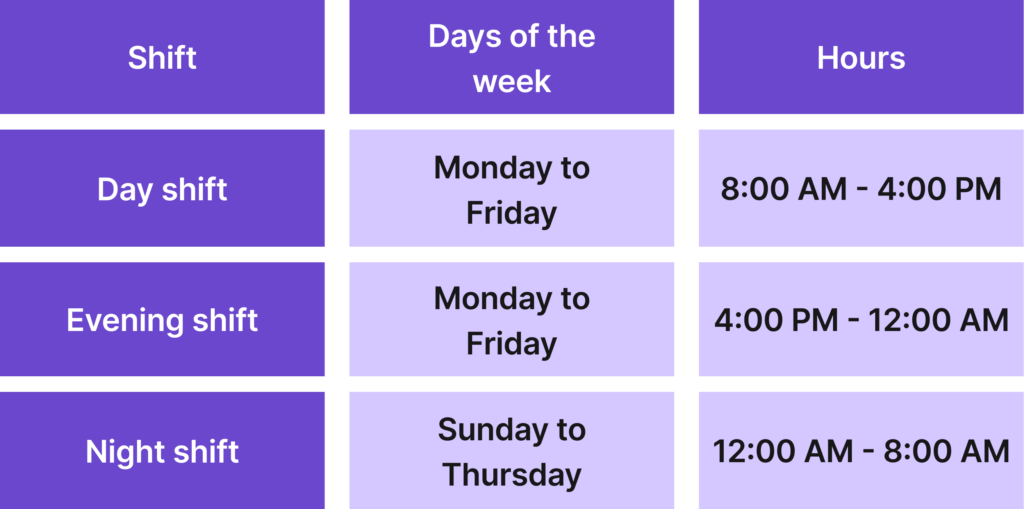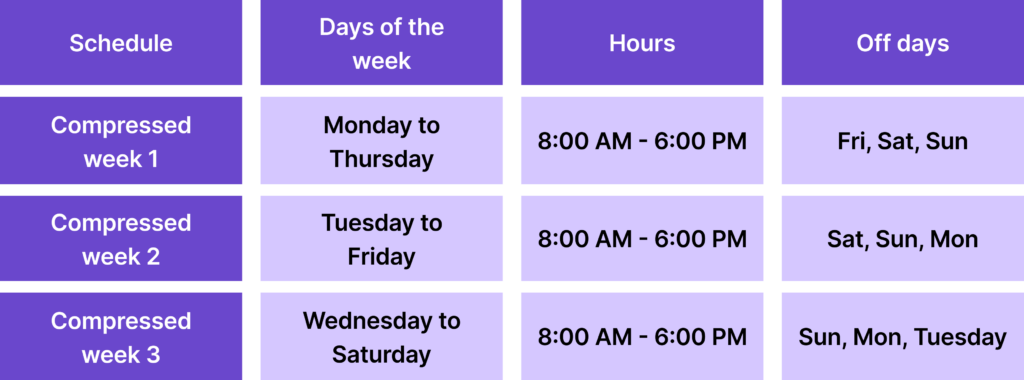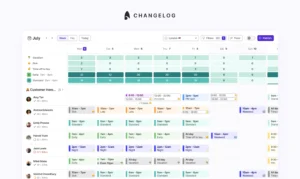
Alternative work schedules in call centres and how to implement them

Most call centres cater to customer needs 24/7, which can be challenging to manage with a standard 9-to-5 schedule.
Alternative work schedules ensure uninterrupted services in call centres that operate beyondregular working hours.
This blog explores alternative work schedules for call centres with examples, their pros and cons, and their implementation.
What is an alternative work schedule?
An alternative work schedule in call centres is a non-traditional shift arrangement that offers flexibility beyond the standard 9-to-5. It offers flexible hours, compressed work weeks, and remote work options. These schedules aim to accommodate diverse needs while maintaining operational efficiency in customer service operations.
Types of alternative work schedules (with examples)
Here are some common alternative work schedules with examples:
1. Shift work
Call centres typically operate 24/7 to provide round-the-clock support. Employees are assigned to different shifts, including day, evening, night, or rotating. This allows the call centre to cover 24 hours of the day and accommodate employees’ preferences or constraints.
Example

In this example, the call centre operates 24/7, and employees are assigned to one of three shifts: day, evening, or night. This schedule ensures coverage around the clock.
2. Part-time and full-time
Call centres often offer part-time and full-time positions. Part-time employees work fewer hours per week, making it suitable for individuals who need flexible schedules, such as students or individuals with other commitments.
Example
This example illustrates the availability of both full-time and part-time positions in a call centre, catering to employees with different availability and work hour requirements.
- Full-time: Employees work 40 hours a week, Monday to Friday, 9:00 AM – 5:00 PM.
- Part-time: Employees work 20 hours a week, with flexible scheduling, allowing them to choose from available shifts based on their preferences and other commitments.
3. Compressed work weeks
In a compressed work week, employees work longer hours on fewer days. For example, following a 4/10 work schedule, surfers (agents) work four 10-hour shifts in a week instead of the standard five 8-hour shifts (5/8 schedule). This can give employees more consecutive days off, making it appealing for those who want extended weekends.
Example

In this compressed work week example, employees follow three different 10-hour work schedules. After their four working days, they get three days off. This pattern repeats every three weeks, with the off days shifting each week.
4. Split shifts
Split shifts involve dividing the workday into two or more segments with breaks in between. Employees might work a few hours in the morning, have a break, and then return for their remaining hours in the afternoon or evening. This can be useful for accommodating employees with specific scheduling needs.
Example

In this example of split shifts, employees work two distinct shifts in a day, with a break in between. This schedule type allows employees to work during preferred times of the day, ensuring continuous coverage during peak hours.
With Surfboard, you can build shift plans and patterns from scratch based on your team’s unique needs. Create separate shifts for different campaigns, holiday seasons, or weekends.
5. Flextime
Flextime allows employees to choose their start and end times within certain limits set by the call centre. This allows employees to adjust their schedules to meet personal or family commitments.
Example

In this example, employees have the flexibility to choose their start and end times within set limits – a start time between – 6 AM and 11 AM and an end time between – 2 PM and 7 PM.
Employee A prefers an early start, while Employee B and Employee C have slightly later start times. This flexibility allows employees to accommodate their personal needs and preferences while working full-time.
6. Rotating days off
A type of rotational schedule, with this schedule type in call centres, employees can have rotating days off instead of fixed days. This ensures that all employees share the burden of working on weekends and holidays fairly.
Example
Below is an example of a rotating day off schedule for a team of surfers over a 4-week period. This schedule assumes a 5-day work week, with two consecutive days off.

In this example:
- Call centre agents work five days a week, typically from Monday to Friday.
- They have two consecutive days off each week.
- The schedule repeats every four weeks, ensuring employees take turns having both weekend days off and working on weekends.
Planning rotating shifts is difficult. However, with Surfboard, managers are no longer required to spend 10+ hours planning shifts.
Surfboard’s break scheduling tool and round-robin scheduling enable a fair and automatic distribution of breaks and shifts, ensuring a more balanced and motivated workforce.
Pros and cons of implementing alternative work schedules
While alternative work schedules offer flexibility and the potential of improved work-life balance, they also come with certain pros and cons. Here’s a breakdown:
Pros
- Enhanced coverage: Alternative work schedules can provide extended coverage hours, ensuring adequate surfer availability for critical business operations even during non-traditional hours or weekends.
- Optimised resource allocation: Workforce managers can strategically schedule employees with the right skills and experience during peak demand periods, improving overall operational efficiency and customer satisfaction.
- Cost savings: By aligning staffing levels more closely with workload fluctuations, organisations can reduce labour costs. They can cut down on overtime and overstaffing expenses.
- Improved employee retention: Offering alternative schedules can be an attractive employee benefit, enhancing job satisfaction and reducing turnover rates.
- Tailored scheduling: Workforce managers can customise schedules to match specific client and employee needs, ensuring that the right people are available during crucial service windows.
Cons
- Complex scheduling: Managing a workforce with diverse schedules can be administratively complex, requiring sophisticated scheduling software and increased coordination efforts.
- Communication challenges: Coordinating meetings, training, and team interactions can be more challenging when employees are on different schedules. It can lead to potential miscommunication and slow down decision-making.
💡Pro tip- Use the right workforce management tool to tackle these challenges. Surfboard simplifies the process of scheduling and managing shifts for your support teams. It enables accurate forecasting and planning schedules.
How to execute an alternative work schedule effectively?
Implementing an alternative work schedule in call centres involves several steps to ensure a smooth transition. Here are five key steps:
1. Assess business needs
Begin by evaluating your call centre’s operational requirements and staffing needs. Consider factors such as peak hours, call volumes, customer service hours, and regulatory or contractual obligations.
2. Involve employees
Engage with your call centre staff to gather input and preferences regarding alternative work schedules. Conduct surveys or meetings to understand their scheduling needs.
3. Develop a scheduling plan
Create a comprehensive scheduling plan that outlines the alternative work schedules. This plan should include shift rotations, start and end times, break schedules, and coverage requirements.
4. Communicate changes effectively
Implement a robust communication plan to inform employees about the upcoming schedule changes. Clearly explain the benefits of the alternative schedules and address any questions or concerns.
Surfboard offers Slack integration allowing you to send shift reminders and notifications whenever schedule changes occur. This ensures your team focuses on providing great customer service without worrying about task switching.
Also, with Surfboard’s draft and publish tool, you can collaborate with your team to edit schedules before publishing them. Track your surfers’ availability, their day offs, and edit schedules in a secure space before sharing.
5. Use the right employee scheduling software
With the right employee scheduling software, you can effectively manage alternative work schedules in your call centre, improve scheduling accuracy, and enhance overall workforce management.
Surfboard’s automated and fairly distributed shift scheduling feature can help you regardless of the schedule type you choose to implement in your organisation. Here are some of Surfboard’s top shift scheduling features👇
✅Forecasting– Use your historical ticket data to predict inflow and understand how many surfers you need 12 weeks into the future.
✅Employee shift scheduling– Build shift plans and patterns from scratch based on your team’s unique needs. Create separate shifts for different campaigns, peak seasons, or even weekends.
✅Timezone management -Set up different global shifts in a few clicks; tell us where your team is based, and Surfboard will do the rest.
Moreover, Surfboard seamlessly integrates with your existing systems like Intercom, Zendesk, Slack, Twilio, and more to boost operational efficiency. You can also add custom integrations at no additional cost.
💡Want to learn more about Surfboard?
Check out how Surfboard made a significant impression on Cuckoo. With Surfboard’s automated scheduling, efficient shift management, intuitive interface, and Intercom integration, this broadband provider experienced 20x growth in 18 months.
Read the detailed case study here.
Book a demo to explore how easy it is to implement alternative work schedules with Surfboard.
FAQs
What are two categories of alternative work schedules?
Two categories of alternative work schedules are flexible schedules, allowing variations in start and end times, and compressed work weeks, where employees work longer hours over fewer days.
What is the 5 4 9 alternate work schedule?
The 5-4-9 alternate work schedule involves working 9-hour days for eight days, one 8-hour day, and one day off in a two-week period.
What are 3 alternative work arrangements?
Three alternative work arrangements include remote work, flextime allowing adjustable work hours, and job sharing, where two employees split the responsibilities of a single full-time position.



